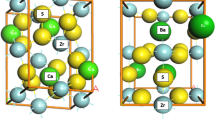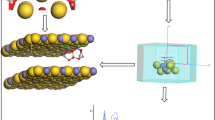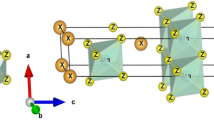Abstract
The structural, electronic and magnetic properties of niobium- and tantalum-doped germanium clusters MGen (M = Nb, Ta and n = 1–19) were investigated by first principles calculations within the density functional theory (DFT) approach. Growth pattern behaviors, stabilities, and electronic properties are presented and discussed. Endohedral cage-like structures in which the metal atom is encapsulated are favored for n ≥ 10. The doping metal atom contributes largely to strengthening the stability of the germanium cage-like structures, with binding energy ordered as follows BE(Gen + 1) < BE (VGen) < BE(NbGen) < BE(TaGen). Our results highlight the relative high stability of NbGe15, TaGe15 and VGe14.

Structure, stability, and electronic properties of niobium-germanium and tantalum-germanium clusters












Similar content being viewed by others
References
Sattler KD (ed) (2017) Handbook of nanophysics clusters and fullerenes. CRC, Boca Raton
Shvartsburg AA, Liu B, Lu Z-Y, Wang C-Z, Jarrold MF, Ho K-M (1999) Structures of germanium clusters: where the growth patterns of silicon and germanium clusters diverge. Phys Rev Lett 83:2167
Yoshida S, Fuke K (1999) Photoionization studies of germanium and tin clusters in the energy region of 5.0-8.8 eV: ionization potentials for Gen (n = 2-57) and Snn (n = 2-41). J Chem Phys 111:3880
Bals S, Van Aert S, Romero CP, Lauwaet K, Van Bael MJ, Schoeters B, Partoens B, Yücelen E, Lievens P, Van Tendeloo G (2012) Atomic scale dynamics of ultrasmall germanium clusters. Nat Commun 3:897
Singh AK, Kumar V, Kawazoe Y (2005) Thorium encapsulated caged clusters of germanium: Th@Gen, n = 16, 18, and 20. J Phys Chem B 109:15187–15189
Wang J, Han JG (2005) A computational investigation of copper-doped germanium and germanium clusters by the density-functional theory. J Chem Phys 123:244303
Wang J, Han JG (2006) A theoretical study on growth patterns of Ni-doped germanium clusters. J Phys Chem B 110:7820–7827
Wang J, Han JG (2006) Geometries and electronic properties of the tungsten-doped germanium clusters: WGen (n = 1-17). J Phys Chem A 110:12670–12677
Hou XJ, Gopakumar G, Lievens P, Nguyen MT (2007) Chromium-doped germanium clusters CrGen (n = 1-5): geometry, electronic structure, and topology of chemical bonding. J Phys Chem A 111:13544–13553
Wielgus P, Roszak S, Majumdar D, Saloni J, Leszczynski J (2008) Theoretical studies on the bonding and thermodynamic properties of GenSim (m + n = 5) clusters: the precursors of germanium/silicon nanomaterials. J Chem Phys 128:144305
Jing D, Tian F, Wang Y (2008) No quenching of magnetic moment for the GenCo (n = 1-13) clusters: first principles calculations. J Chem Phys 128:124319
Wang J, Han JG (2008) Geometries, stabilities, and vibrational properties of bimetallic Mo2-doped Gen (n = 9-15) clusters: a density functional investigation. J Phys Chem A 112:3224–3230
Zhao WJ, Wang YX (2008) Geometries, stabilities, and electronic properties of FeGen (n = 9-16) clusters: density-functional theory investigations. Chem Phys 352:291–296
Zdetsis AD (2009) Silicon-bismuth and germanium-bismuth clusters of high stability. J Phys Chem A 113:12079–12087
Sosa-Hernandez EM, Alvarado-Leyva PG (2009) Magnetic properties of stable structures of small binary FenGem (n + m ≤ 4) clusters. Phys E 42:17–21
Zhao WJ, Wang YX (2009) Geometries, stabilities, and magnetic properties of MnGen (n = 2-16) clusters: density-functional theory investigations. THEOCHEM J Mol Struct 901:18–23
Bandyopadhyay D, Kaur P, Sen P (2010) New insights into applicability of Electron-counting rules in transition metal encapsulating Ge cage clusters. J Phys Chem A 114:12986–12991
Bandyopadhyay D, Sen P (2010) Density functional investigation of structure and stability of Gen and GenNi (n = 1-20) clusters: validity of the Electron counting rule. J Phys Chem A 114:1835–1842
Bandyopadhyay D (2012) Architectures, electronic structures, and stabilities of cu-doped Gen clusters: density functional modeling. J Mol Model 18:3887–3902
Kapila N, Jindal VK, Sharma H (2011) Structural, electronic and magnetic properties of Mn, co, Ni in Gen for (n = 1-13). Phys B 406:4612–4619
Kapila N, Garg I, Jindal VK, Sharma H (2012) First principle investigation into structural growth and magnetic properties in GenCr clusters for n = 1-13. J Magn Magn Mater 324:2885–2893
Kumar M, Bhattacharyya N, Bandyopadhyay D (2012) Architecture, electronic structure and stability of TM@Gen (TM = Ti, Zr and Hf; n = 1-20) clusters: a density functional modeling. J Mol Model 18:405–418
Samanta PN, Das KK (2012) Electronic structure, bonding, and properties of SnmGen (m + n ≤ 5) clusters: a DFT study. Comput Theor Chem 980:123–132
Shi S, Liu Y, Zhang C, Deng B, Jiang G (2015) A computational investigation of aluminum-doped germanium clusters by density functional theory study. Comput Theor Chem 1054:8–15
Deng XJ, Kong XY, Xu XL, Xu HG, Zheng WJ (2014) Structural and magnetic properties of CoGen − (n = 2-11) clusters: photoelectron spectroscopy and density functional calculations. Chem Phys Chem 15:3987–3993
Deng X-J, Kong X-Y, Xu H-G, Xu X-L, Feng G, Zheng W-J (2015) Photoelectron spectroscopy and density functional calculations of VGen − (n = 3-12) clusters. J Phys Chem C 119:11048–11055
Jin Y, Tian Y, Kuang X, Lu C, Cabellos JL, Mondal S, Merino G (2016) Structural and electronic properties of ruthenium-doped germanium clusters. J Phys Chem C 120:8399–8404
Mahtout S, Tariket Y (2016) Electronic and magnetic properties of CrGen (15 ≤ n ≤ 29) clusters: a DFT study. Chem Phys 472:270–277
Jaiswal S, Kumar V (2016) Growth behavior and electronic structure of neutral and anion ZrGen (n = 1-21) clusters. Comput Theor Chem 1075:87–97
Lu S-J, Hu L-R, Xu X-L, Xu H-G, Chen H, Zheng W-J (2016) Transition from exohedral to endohedral structures of AuGen (n = 2-12) clusters: photoelectron spectroscopy and ab initio calculations. Phys Chem Chem Phys 18:20321
Siouani C, Mahtout S, Safer S, Rabilloud F (2017) Structure, stability, and electronic and magnetic properties of VGen (n = 1-19) clusters. J Phys Chem A 121:3540–3554
Mahtout S, Siouani C, Safer S, Rabilloud F (2018) Growth behavior and electronic structure of Noble metal-doped germanium clusters. J Phys Chem A 122:662–677
Tran VT, Nguyen MT, Tran QT (2017) A computational investigation of the geometrical and electronic structures of VGen −/0 (n = 1-4) clusters by density functional theory and multiconfigurational CASSCF/CASPT2 method. J Phys Chem A 121:7787–7796
Tran VT, Tran QT (2018) The electronic structures of CoGen −/0 (n = 1-3) clusters from multiconfigurational CASSCF/CASPT2 and RASSCF/RASPT2 calculations. J Phys Chem A 122:6407–6415
Tran VT, Tran QT (2018) Spin state energetics of VGen −/0 (n = 5-7) clusters and new assignments of the anion photoelectron spectra. J Comput Chem 39:2103–2109
Liang XQ, Deng XJ, Lu SJ, Huang X, Zhao J, Xu HG, Zheng W-J, Zeng XC (2017) Probing structural, electronic and magnetic properties of Iron-doped semiconductor clusters Fe2Gen −/0 (n = 3-12) via joint photoelectron spectroscopy and density-functional study. J Phys Chem C 121:7037–7046
Liang XQ, Kong X, Lu SJ, Huang Y, Zhao J, Xu HG, Zheng W, Zeng XC (2018) Structural evolution and magnetic properties of anionic clusters Cr2Gen (n = 3-14): photoelectron spectroscopy and density functional theory computation. J Phys Condens Matter 30:335501
Fioressi SE, Bacelo DE (2017) Structures and energetics of BenGen (n = 1-5) and Be2nGen (n = 1–4) clusters. Mol Phys 117:1502–1513
Borshch NA, Kurganskii SI (2018) Atomic structure and electronic properties of anionic germanium–zirconium clusters. Inorg Mater 54:1–7
Perdew JP, Burke K, Ernzerhof M (1996) Generalized gradient approximation made simple. Phys Rev Lett 77:3865–3868
Soler JM, Artacho E, Gale JD, García A, Junquera J, Ordejón P, Sánchez-Portal D (2002) The SIESTA method for ab initio order-N materials simulation. J Phys Condens Matter 14:2745–2779
Troullier N, Martins JL (1991) Efficient pseudopotentials for plane-wave calculations. Phys Rev B: Condens Matter Mater Phys 43:1993–2006
Kleinman L, Bylander DM (1982) Efficacious form for model pseudopotentials. Phys Rev Lett 48:1425–1428
Gadiyak GV, Morokov YN, Mukhachev AG, Chernov SV (1982) Electron density functional method for molecular system calculations. J Struct Chem 22:670–674
Kingcade JE, Nagarathna-Naik HM, Shim I, Gingerich KA (1986) Electronic structure and bonding of the molecule Ge2 from all-electron ab initio calculations and equilibrium measurements. J Phys Chem 90:2830–2834
Frisch MJ et al (2013) Gaussian09, Revision D.01. Gaussian Inc., Wallingford
Parr RG, Yang W (1989) Density functional theory of atoms and molecules. Oxford University Press, New York
Acknowledgments
F.R. thanks the GENCI-IDRIS (Grant A0050807662) center for generous allocation of computational time.
Author information
Authors and Affiliations
Corresponding authors
Additional information
Publisher’s note
Springer Nature remains neutral with regard to jurisdictional claims in published maps and institutional affiliations.
Rights and permissions
About this article
Cite this article
Siouani, C., Mahtout, S. & Rabilloud, F. Structure, stability, and electronic properties of niobium-germanium and tantalum-germanium clusters. J Mol Model 25, 113 (2019). https://doi.org/10.1007/s00894-019-3988-5
Received:
Accepted:
Published:
DOI: https://doi.org/10.1007/s00894-019-3988-5




